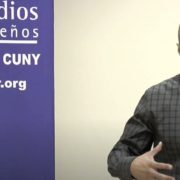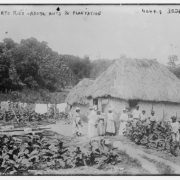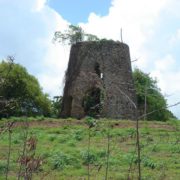Espiritismo:The Flywheel of the Puerto Rican Spiritual Traditions
by Edil Torres Rivera, University of Florida, Gainesville, USA
Abstract
Espiritismo (spiritism) is a wide-spread religious practice among Puerto Ricans in Puerto Rico and Puerto Ricans in the United States. Espiritismo has been found to be effective in healing people and having similar effects with clients in counseling and psychotherapy. Puerto Rican espiritismo is a syncretism belief system that combines pre-Columbian, African, Catholic, and European spiritual-religious practices into one system to fulfill the spiritual needsas well as the psychocultural needs of the Puerto Rican people. Implications and suggestions are also provided forcounselors wanting to use espiritismo in their practices with Puerto Rican clients
The use of indigenous and native healing practices has been given a great deal of attention in the multicultural counseling field in the last ten years (Brawer, Handal, Fabricatore, Roberts, & Wajda-Johnston, 2002; Sue & Sue,2003). However, much of that attention has been concentrated in working with American Indians (Garrett,1998; Garrett & Garrett, 2002; Herring, 1997; Pope,2002). While the attention given to the use of folk healing techniques with various ethnic groups in mental health settings since the early 1980s has not been without criticism, only small amounts of information have been written about the use of native healing practices with Latinos (Comas-Díaz, 1981; Jorge, 1995; Loeb Adler, &Mukherji, 1995; Núñez Molina, 1989; Richards & Bergin, 2000; Zea, Mason, & Murguía, 2000). A review of the literature indicates that most of the work done on this subject in reference to Latinos has been conducted specifically with Cubans and Santeria (Altarriba & Bauer, 1998) or both. Although, the subject needs to expand on Puerto Ricans in the mental health field, the three most recent works about the subject include one book chapter with a small segment on espiritismo (spiritism), another book concentrating on Puerto Rican women as healers, and an article about the botánicas in Puerto Rico and the Dominican Republic (Delgado & Santiago,1998; Koss-Chioino, 1992; Zea, Mason, & Murguía, 2000).
The use of espiritismo has been identified as an alternative treatment approach when working with Puerto Ricans in mental health settings (Comas-Díaz, 1981; Harwood, 1987; Koss, 1975; Morales-Dorta, 1976; Jorge,1995; Rogler & Hollingshead, 1960; Zea, Mason, &Murguía, 2000). The importance of the subject in the mental health of Puerto Ricans has been well documented in the Coleción de Puerto Rico at the library of the Universityof Puerto Rico, Mayagüez campus. This collection contains a number of small articles referring to the influence of the Catholic faith in the use and practice of espiritismo among Puerto Ricans (de Armas, 1979; Núñez Molina, 1991a, 1991b).
For Puerto Ricans the use of espiritismo is an importantpart of their religious faith that provides an important sourceof emotional support (Altarriba & Bauer, 1998; Comas-Díaz, 1981). The flywheel, a wheel that moderates thefluctuation and speed in a machine, is a metaphor toillustrate espiritismo as an ethnocultural faith that maintains balance among four different cultures. Puerto Rican espiritismo has not only dealt with opposing religious beliefs, but cultures as well (if the United States invasion in 1848 is included). Espiritismo is not a new phenomenonas illustrated in a 1972 survey conducted by the most read newspaper in Puerto Rico at the time, “El Mundo,” which indicated that about 86% of the total Puerto Rican population performed some kind of espiritismo ritual and about 96% of the Puerto Rican population have some knowledge of the espiritista faith (de Armas, 1979). In a personal conversation with Dr. Edgardo Melendez, the director of the Institute for Social Research at the University of Puerto Rico, he stated that the percentage of those believing and practicing the espiritista faith has grown even more in the last five years, mainly among professionals (Edgardo Melendez, Director of the Institute of Social Research, personal communication, August 15,1999). The purpose of this article is to discuss theintegration of espiritismo when working with Puerto Ricanclients by describing the following: a) background ofespiritismo as a spiritual tradition, b) the practice of espiritismo, c) Puerto Rican espiritismo, d) botánicas, and e) implications for counseling.
Background of Espiritismo as a Spiritual Tradition
Espiritismo can be traced back to France around the1850’s. The founder of Espiritismo was the French educator León Hipólito Denizard Rivail. He adopted the name of Allan Kardec after claiming to have received a revelation that he was a priest in his previous life (Pérez García, 1986). Henceforth, he became interested in psychical and other supernatural phenomenon. He simultaneously became involved in meetings where people were communicating with the spirits that offered spiritual messages. Kardec asked the spirits questions through the mediums and with this information it is believed that Kardec wrote the Book of the Spirits (1978).
So what is espiritismo? According to Kardec (1968), it is the collection of principles and laws, which includes all areas of human knowledge, activities, and the behavior of human beings. Therefore it can and should be studied, analyzed and put into practice in all fundamental aspects of life, such as science, philosophy, religion, ethics, morality, education and social life. Some fundamental points of espiritismo are: 1) God is the supreme intelligence and primary cause of all things. 2) Beyond the physical world, which is the habitation of incarnate spirits (humankind), there is existence of the spiritual world, which is the habitation of discarnate spirits. 3) All spirits are created simple and naïve. They gradually evolve, intellectually and morally, passing from an inferior order to more elevated levels until they finally reach perfection, where they will enjoy constant happiness. 4) All spirits preserve their individuality, before, during, and after each incarnation. Spirits reincarnate as many times as necessaryin order to achieve their own perfection. 5) The different corporeal existences of the spirit are always progressive and never regressive. The rapidity of their progress, both intellectually and morally, depends upon the degree of effort made towards betterment. 6) According to the degree of perfection they have attained at any one time, spirits pertain to various orders. These orders include pure spirits who have attained maximum perfection, good spirits whose desire towards goodness predominates, and imperfect spirits who are characterized by ignorance, by their desires towards evil, and by their inferior passions. The relationship of spirits with human beings is constant and has always existed. The good spirits do their best to lead us towards goodness and uphold us during our trials, helping us through support marked by courage and resignation. In contrast, the imperfect spirits try to incite us towards evil. 7) The future life reserves penalties or compensations compatible and in accordance with each human’s behavior while incarnate and as to whether or not God’s laws were respected.
The Practice of Espiritismo
The practice of espiritismo is held within the Christian principle that God should be adored in spirit and truth. There is no ministry within espiritismo, which neither adopts nor uses any of the following in meetings or practices: vestments, alcoholic beverages, incense, tobacco, altars, banners, candles, processions, talismans, amulets, sacraments, the making of promises and the paying of penance, horoscopes, fortune telling with cards or seashells, pyramids, crystals, rituals or any other form of exterior cult. Espiritismo does not impose its principles but rather invites all those who are interested in the principles to submit its teachings to the test of reason before accepting them. This particular characteristic of espiritismo allows the integration of other faiths into its practice, as it is in the case of Puerto Rican espiritismo, which will be described later in the Puerto Rican espiritismo section. Mediumship is another important part of espiritismo, as it allows the communication of the spirits with Humankind. It is a gift that anyone can have regardless ofthe doctrinal guidance he or she may choose to follow. Espiritismo mediumship is only that which is practiced based upon the principles of the espiritismo doctrine and within Christian morality. As stated earlier, espiritismo respects all religions, valorizes all efforts towards the practice of goodness, and recognizes that a true person of goodness is one who fulfills the laws of justice, love, and charity in their greatest form of purity (Kardec, 1986).
Puerto Rican Espiritismo
Espiritismo was introduced to Puerto Rico during the second part of the 19th century (Cruz Monclova, 1952).The books of Kardec (Instrucción práctica sobre las manifestaciones espiritistas, 1975; El Libro de los Espíritus, 1978; and ¿Qué es Espiritismo?, 1986) became very popular among the Puerto Rican intellectual community. Puerto Rican espiritistas met secretly for some time because the Spaniard government persecuted them under the belief that espiritistas were political revolutionaries (Yañez, 1963). While the oppression against the espiritistas from the Spaniard government continued, the practice of espiritismo grew and various centros (centers) were established on the island. The first centro was established in Mayagüez in 1881 with the name “Renacimiento.” Puerto Rican espiritistas leaders believed that the study of espiritismo was essential to the intellectual and moral development of individuals. Therefore, they organized a number of projects that led to the contributions of libraries and newspapers in the community (Rodríguez Escudero, 1978). In 1903, a group of espiritistas founded the Federación de Espiritistas de Puerto Rico (Puerto Rican Federation of Spiritists). The Federación emphasized education to espouse the doctrine that the practice of espiritismo should not be practiced as a religion. Up to this point, the practice of espiritismo in Puerto Rico was mainly a middle class (intellectuals andacademics) practice.
Nonetheless, low socioeconomic status Puerto Ricans eventually became attracted by espiritismo because of its theme that teaches about suffering with resignation and tests that people must endure (fatalism) before obtaining moral perfection. Espiritismo also became attractive for poor and working class Puerto Ricans because of its Christian orientation and the ability of espiritismo to incorporate other beliefs and religions. It is possible that the working class and poor Puerto Ricans were attracted to espiritismo because of its emphasis on the spiritual world and the postponement of immediate gratification and pleasure in order to obtain spiritual goals.
Folklore Espiritismo or Eclectic
This type of espiritismo is different from Kardec (1968) espiritismo. In fact, it is very similar to the Puerto Rican ethnic identity (Rivera Ramos, 2001; Torres-Rivera, 2004) in that this espiritismo is truly a combination of different religious beliefs such as African beliefs, Tainos beliefs, and European beliefs (Catholic and Protestant). Being the most popular type of espiritismo in Puerto Rico, this type of espiritismo is also known as Mesa Blanca (Jorge, 1995) and the espiritista medium is known as the“psychiatry of the poor.” The most important event of the Mesa Blanca practices is the reunión of session, which takes place in the centro. The physical setting of the centro is very similar everywhere. The name Mesa Blanca comes from the fact that in the middle of the room in which the session is to be conducted is a large table covered with a white cloth. At the table where the leader and the other mediums collaborate in the work of the causes, healings, or exorcists, a number of other things from water to cigars can also be found. This is where Mesa Blanca practices borrow from other sources. From the Catholic religion, the practice of this particular type of espiritismo has borrowed figures of saints (Santos de Palo), portraits of Christ, Virgin Mary, and Santa Barbara. In addition, Mesa Blanca borrowed the use of incense, holy water, prayers, and Christianity.
From the African culture, Mesa Blanca adopted the use of the seven African divinities including Changó (SantaBarbara), Orula, Orúnla (San Francico de Asisi), Ochún (La Caridad del Cobre), Obatalá (Las Mercedes), Elegua, Echu (San Antonio, San Benito el Moro, San Martín dePorres), Ogún (San Pedro), Yemayá, Yemalia (Regla, La Milagrosa). Also, rum is present to be served to the spirits during the sessions (Harwood, 1987). The use of herbs can also be traced to African traditions but is unclear whether this practice was adopted by the Tainos or by the Africans slaves when they arrived in Puerto Rico (Harwood,1987; Sued-Badillo & Lopéz-Cantos, 1986).
The Taino cultural influence in this traditional religion is also very visible. Practices such as the cleansing of the house or self-using tobacco and incense, the smoking of cigars to help individuals develop their medium capacities, are among the practices that can be traced to Taino religious practices (Gómez Acevedo & Ballesteros Gaibrois, 1978;Rouse, 1992). Praying to deceased ancestors for help is also a Taino tradition. The use of herbs and use of the four directions for guidance and balance can also be traced to Taino culture. The animism of the Tainos can still be seen in the Santos de Palo tradition that is found in the centros decorating the altars (Acevedo & Ballesteros Gaibrois, 1978; Harwood 1987; Rouse, 1992).
Puerto Rican Espiritismo and Christianity
Christianity and espiritismo are similar in the way they view the dual nature of human beings as material animal and eternal spirit, and the hierarchy of spiritual perfection in which higher order disincarnate members have special protective relationship with incarnate souls. Nevertheless, espiritismo is different from Christianity because of the importance it places on direct communication between embodied and disembodied spirits and consequently in how much it values the development and use of mediumistic abilities.
The question is how faiths or religious practices such as Christianity and espiritismo mix with principles opposite to each other such as reincarnation and migration of souls. Espiritismo is no different from many African ethnocultural faiths (Burns, 2002) but rather than being absorbed by Christianity, espiritismo absorbed Christianity. Therefore, espiritismo does not prevent people who belief in espiritismo from concurrently interacting or participating in other religions. Of course religions such as Catholicism and Protestantism see the participation of espiritismo rituals as evil. Nonetheless, the incredible flexibility that espiritismo provides has allowed the development of a unique faith that accommodates differences and offers its followers less rigidity than organized religions such as Catholicism and Protestantism. While it is not clear why espiritismo is able to reconcile the differences of Christianity, African, and Taino religious and spiritual beliefs, it is clear that the flexibility of espiritismo is evidenced in the liquidity and complexity of the Puerto Rican ethnic identity (Hardwood,1987; Morales-Dorta, 1976; Rivera, Ramos, 2001; Torres-Rivera, 2004)
The Botánicas
Botánicas are another illustration of how espiritismo seems to serve as a flywheel to maintain balance between different spiritual beliefs among Puerto Ricans. Botánicas are herb shops in which espiritistas and other believers can purchase candles, literature, potions, and other paraphernalia that are essential ingredients for the rituals and other religious practices. The popularity of botánicas in Puerto Rican neighborhoods in the United States as wel las in every barrio in Puerto Rican towns is also a silent witness to the importance of this practice among Puerto Ricans in general. One very important aspect of the popularity of botánicas and an important issue that will be discussed in this paper is the presence of a variety of different influences on the Puerto Rican culture. In the botánica, the articles that the believer will find are not only related to the legacy of espiritismo as it was intended by Alan Kardec, but to everything that comprises the complexity of the Puerto Rican spiritual and magical world. Therefore, it may not be unusual to find an image of Santa Barbara next to a Native American Chief or spiritual leader (see figures 1 and 2). As mentioned earlier, in the botánica one can find specialized potions, candles, charms, herbs, plants, books, and other artifacts used in the magical and spiritual world (Casillas, 1993). The botánica provides the casual visitor with a display of diversity that can be found in Latino cultures and particularly in Puerto Rican towns. In other words, the espiritismo practiced by Puerto Ricans is as liquid and complex as the Puerto Rican ethnic identity (Torres-Rivera, 2004). While Puerto Ricans cannot deny the influence of Africa in their beliefs, it is equally important to recognize the influence of the Arawaks in the practice of espiritismo, as both of these cultural traditions exert their influence on contemporary spiritual practices by Puerto Ricans (Sued-Badillo & Lopéz-Canto, 1986). A visit to a botánica will summarize the cultural and ethnic history of the Caribbean in the last 500 plus years. The botánicas provide visual evidence on how each belief syncretism into one flexible spiritual faith.
Implications
Counselors working with Puerto Rican clients who practice espiritismo may benefit from knowing that people who believe in espiritismo have a collective worldview. Therefore, group therapy usually is a more acceptable form of therapy. In addition, espiritistas are very active in diagnosing or telling people what is wrong with them, thus, when working with clients who practice espiritismo, counselors must be active in pointing out the clients’ ailment. This type of behavior creates respecto to the counselor and increases credibility in the community because counselors are seen as experts and their expertise is displayed by their ability to diagnose. Correspondingly, counselors are expected to take part of the “reunion” and to be familiar with the espiritista rituals and traditions. That is, while the spirituality issue has become an important one in counseling and psychotherapy, issues of religion and spirituality among Latinos are personal and moral in nature (Zea, Mason, & Murguía, 2000), therefore, Latinos must feel that counselors have an understanding and respect for the practice of espiritismo.
Finally, an important implication for counselors working with clients whose spiritual faith is espiritismo is that for many Puerto Ricans, espiritismo is a way of life, a method of perceiving reality and understanding their mission in life, and a style of solving daily family and health problems. Espiritismo, in essence, is a way of understanding, connecting, and reaffirming Puerto Ricans with their ethnic identity and as spiritual beings.
Conclusion
The nature of espiritismo, as conceived by Kardec (1986), allows the syncretism of four different cultures (African, Taino, European, and United States) of religious and spiritual beliefs into one (Díaz, 1996). Similar to the ethnic identity phenomenon that long has been illustrated in the Puerto Rican literature, the eclectic nature of espiritismo gives Puerto Ricans a flexible means to rehearse the ongoing formation of their cultural identity(González, 1998; Torres-Rivera, 2004). Furthermore, espiritismo permits Puerto Ricans to empower themselves through the interaction between humans, spirits, and God, which lead to self-determination and independence.
As stated earlier, the botánicas are also evidence of the blend of different cultures and the diversity in how Puerto Ricans perceive spiritual matters. In the botánica, the customer will find prayer books of Alan Kardec, candle s in different colors (the colors signify the different spirits and the four directions), a number of images ranging from Santa Barbara to snakes, fetishes, herbs, incense, perfumes, and potions to treat a number of illnesses. Also, the botánica is the point of contact for some mediums, espiritistas, curanderos, and santiguadores or both.
Since the works of Braum (1958) and until now, Puerto Rican espiritismo has been studied from a psychotherapeutic perspective, indicating that Puerto Rican espiritismo is more than simply a form of counseling for the poor (Núñez Molina, 1989; Morales-Dorta, 1976; Zea,Mason, & Murguía, 2000). Harwood (1987) indicated that espiritismo works in similar ways to conventional counseling in that espiritismo folk healing rituals are harmonious with the Puerto Rican culture and thus more effective than conventional counseling as the cultural expectations of the Puerto Rican believer are fulfilled by this traditional indigenous religion.
Furthermore, earlier studies and studies in Africa provide evidence that when counselors and other mental health professionals incorporate traditional healers, their credibility and ability to help people from the community increases (Ruiz, 1976). This creates a sense of community and familialismo. Because counseling approaches have been labeled as reductionistic (Sue, Ivey, & Pedersen,1996) and myopic in their approach to help Latinos (Torres-Rivera, 2004), alternative approaches need to be considered in order to serve Latino populations in a more culturally sensitive and appropriate manner. For this reason espiritismo provides a holistic, humanistic, and spiritual helping approach for counselors working with PuertoRicans.









![At work in the cane field, tying bundles of fallen stalks, Porto [sic] Rico Abstract/medium: 1 photographic print on stereo card stereograph. 1923](https://simplybridges.com/wp-content/uploads/2022/06/At_work_in_the_cane_field_tying_bundles_of_fallen_stalks_Porto_sic_Rico_LCCN2003680335-180x180.jpg)


Leave a Reply
Want to join the discussion?Feel free to contribute!